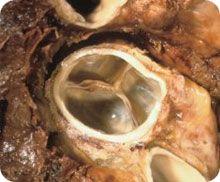Tricuspid Valve Stenosis
Written By: Adam Pick, Patient Advocate, Author & Website Founder
Page Last Updated: May 10, 2025
Tricuspid valve stenosis is most often a result of rheumatic fever. The tricuspid valve is the passage between the right chambers (atrium and ventricle) of the heart. Tricuspid valve stenosis causes a reduced transfer of blood from the atrium to the ventricle. Consequently, the right atrium becomes enlarged but the right ventricle does not receive enough blood.

What Is Tricuspid Valve Stenosis?
The largest of the four heart valves is called the tricuspid valve. It is located between the right upper and lower (atrium and ventricle) chambers of the heart. Stenosis is a Greek word that is defined as "narrowing or constricting space". Therefore, stenosis is diagnosed when a vessel or passage is narrowed or restricted.
A normal tricuspid valve operates smoothly, regulating the flow of blood from the right atrium to the right ventricle. The opening of a stenotic tricuspid valve is narrow and stiff, restricting blood flow from the atrium to the ventricle.
As the tricuspid valve becomes more stenotic, it becomes increasingly more difficult for blood to be passed from the right atrium to the right ventricle. Therefore, blood begins to pool in the atrium and enlarge it, while the ventricle does not receive enough blood and it begins to shrink. A shrunken ventricle reduces the cardiac output of blood.
Diagnosing Tricuspid Stenosis
When a physician listens to your heart beat, a mild murmur caused by the blood flowing through the stenotic valve can be heard. The physician will typically order an echocardiography so that the diagnosis can be confirmed and also the severity of the condition can be determined.
What Are The Symptoms of Tricuspid Stenosis?
There are few symptoms to report. Many patients with this condition at times report feeling:
- tired and lethargic
- fragility
- a quivering feeling in the neck
- a rapid, irregular heartbeat called a palpitation, or both.
- pain in the upper right part of their abdomen which may be caused by an enlarged, congested liver.
Symptoms are rarely dramatic enough to require surgery to replace the tricuspid valve.
What are the Causes of Tricuspid Valve Stenosis?
Tricuspid valve stenosis is usually caused by having contracted rheumatic fever during childhood. The rarely reported second cause of tricuspid valve stenosis is a tumor or connective tissue disease. A very tiny percentage of people are born with this condition and so have congenital tricuspid valve stenosis.
This condition is not affected by family history and you cannot “catch” it.
How is Tricuspid Stenosis Treated?
Treatment is dependent upon the severity of your condition. Tricuspid valve stenosis by itself doesn’t typically require treatment. Your treatment could include:
- Monitoring – If your tricuspid valve stenosis falls within the mild to moderate category, your physician may decide to just watch it carefully through occasional medical appointments.
- Medication - There is no medicine that can correct tricuspid valve stenosis. Certain medicines may be prescribed to ease the workload of the heart and regulate the rhythm. However, since people who have this condition are at increased risk for heart infections, your physician may prescribe precautionary antibiotics. Precautionary antibiotics are taken to prevent bacterial endocarditis (an infection of the heart tissue) when procedures such as dental surgery are necessary.
- Surgery - It is possible that your physician may decide to repair or replace the stenotic tricuspid valve with a biological or mechanical devices. Occasionally, if other valves in the heart are damaged as well, surgery may be recommended to repair or replace the tricuspid valve.
You Might Also Like
To help you learn more about tricuspid stenosis, here is additional information to educate and empower you:
- Bacterial Endocarditis: What Should You Know?
- Calcified Heart Valve Leaflets
- Tricuspid Valve Repair
- Tricuspid Valve Replacement
- Echocardiograms & Heart Valve Disease
- Meet Heart Valve Patients in Our Community




